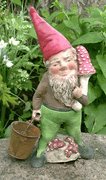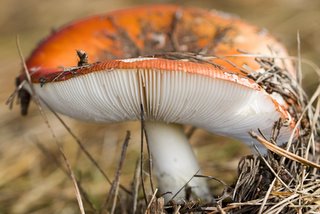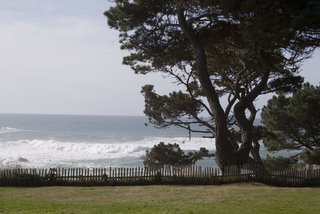http://www.cdfa.ca.gov/ahfss/ah/avian_health3.htmBecause we live in the Pacific Flyway, this is pertinent information for people with backyard chickens and wild bird feeders. See the announcement from
UC Ag. and Natural Resources (UCANR) below:
November 1, 2005
CONTACT: Jeannette Warnert, (559) 240-9850, jwarnert@ucop.edu
California chicken owners should be on the lookout for avian flu This fall and winter, as migratory birds make their way down the Pacific Flyway, they may be packing avian flu, including the deadly and much-publicized H5N1 variant.
The University of California offers resources and information to help commercial-scale poultry producers, families with pet chickens and all poultry owners in between prevent infection, diagnose potential diseases and stop the spread should a severe bird illness be identified in the state.
Fortunately, avian flu fears need not threaten a cherished American tradition: the Thanksgiving turkey. Avian flu cannot be transmitted by handling store-bought turkey or other poultry nor from eating it.
"There is absolutely no risk in eating poultry," said UC Davis-based Cooperative Extension poultry specialist Francine Bradley.
Bradley also assures the public that there is no reason to get rid of chickens at this time. Bradley, herself a former chicken owner, says poultry can make amusing pets while providing families with some fresh eggs.
One such family is the Shapiros of Ahwahnee, a foothill community in rural Madera County. They have kept poultry for years -- all three children have been active in 4-H poultry programs -- but they no longer allow their 16 chickens and one turkey to run loose during the day, as they had in the past. Nevertheless, the Shaprios are committed to keeping their birds.
"Poultry are easy to take care of, cheap, fun and friendly," Carol Shapiro said. Her 14-year-old son Jacob has had great success in 4-H poultry judging competitions and will go to Kentucky in November for a national contest.
Ten-year-old Luke taught one chicken to jump over a stake. "They're smart and they have personality," Luke said as he stroked his chicken.
Carol Shapiro said she is not yet concerned about her children's close proximity to poultry. "In 4-H, the kids have learned how to protect chickens from diseases. We also went online to get information about avian flu," she said. "We've been watching our birds and listening for news."
Wild birds are most frequent source of avian flu virus Avian influenza viruses occur all over the world. Free-flying aquatic birds have been the most frequent source of the virus. Ducks, geese, gulls and shorebirds are considered the principal reservoirs.
In poultry, avian flu ranges widely in severity. Some infected birds show no symptoms at all; others die suddenly. The variant making world headlines -- H5N1 -- is deadly to chickens and turkeys, but only sickens ducks, making them potentially very efficient at spreading the disease.
Most troubling, over the past two years, avian influenza H5N1 has sickened 121 people in Southeast Asia, and killed 62 of them, according to the World Health Organization. So far, almost all human cases have been identified in people who had contact with infected poultry. Some media outlets are reporting that human-to-human transmission is suspected in a few cases. Scientists fear the virus will mutate to allow rapid human-to-human transmission, a development that could cause a severe worldwide flu epidemic.
California susceptible to avian flu California birds could play a significant role as the avian flu story unfolds in the coming weeks and months. Scientists believe migratory waterfowl who find hospitable wintering grounds in California may travel from as far away as Siberia, a location in Eastern Russia that has reported cases of H5N1 bird flu. The means of spreading the infection to birds on California farms and backyards is not hard to imagine. A wild bird with avian flu could touch down for a break on a poultry owner's premises or simply fly over and shed the virus in droppings.
Bradley said all backyard poultry in California are safest inside a flight pen with a small hen house attached.
"Make sure the roof of the pen has a solid cover to protect birds from virus that may drop from birds flying overhead," Bradley said.
Bradley recommends bird owners follow customary poultry biosecurity measures -- techniques that protect pets and commercial animals from many diseases that threaten the health of poultry.
"We always tell people, don't let anyone near your birds who doesn't need to be there," Bradley said.
Personal sanitation is also important, she said.
"After visiting a park or lake, a neighbor's farm or anywhere birds are present, clean and disinfect shoes before returning to the poultry pen," Bradley said.
People who wish to allow the birds to run loose and free-range producers should keep all food and water under cover so they don't attract wild birds.
Free bird flu diagnostic services Signs of avian flu are similar to flu symptoms in humans: coughing, sneezing, low productivity and depression. Immediately isolate sick animals from healthy ones, Bradley said. If the bird is a valued pet, take the animal to the veterinarian’s office for testing. Bradley suggests finding an experienced poultry veterinarian.
Free diagnostic services are available to the public at the UC Davis School of Veterinary Medicine's five California Animal Health and Food Safety Laboratories, located in San Bernardino, Tulare, Fresno, Turlock and Davis. However, there are caveats.
"Once a bird is here, it doesn't leave the premises," said Rocio Crespo, a veterinary diagnostician at the Fresno laboratory. "If the owner is willing to have the bird euthanized, the service is free of charge. We conduct a necropsy and then incinerate all carcasses."
The laboratories also accept dead birds for testing. Crespo suggests keeping the bird refrigerated and delivering it to the laboratory within two days.
An option for bird owners who want to keep their birds alive but can't afford a veterinary visit involves some do-it-yourself sample collection. A small amount of the bird's blood may be drawn and delivered to the laboratory within 24 hours. Perhaps even easier, the owner may wipe a sterile swab in the bird's mouth and throat and then take another swab sample in the bird's backside where droppings come out. The sample swabs may be delivered to the laboratories in zipper-closed plastic bags. For an $8.25 fee for each swab, the lab will conduct tests to determine whether the bird has an H5 form of avian flu. (Addresses, driving directions and contact information for the five California Animal Health and Food Safety Laboratories are here:
http://cahfs.ucdavis.edu/show.php?id=200)
The UC Davis Department of Animal Science offers avian flu information on its Web page at
http://animalscience.ucdavis.edu/Avian/Web%20page%20AI%20hyperlinks.htm .








